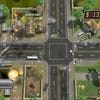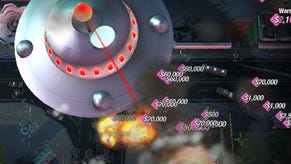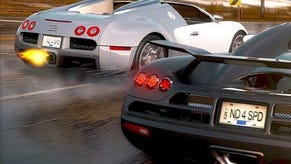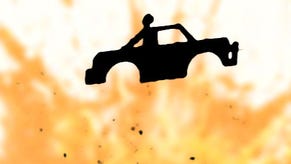Burnout Crash!
Demolition in motion.
EA's Summer Showcase is a very American affair. In the collegiate atmosphere of Redwood Shores, the company's sprawling San Francisco campus HQ, the word “awesome” echoes throughout presentations for the upcoming EA Sports roster, as producers and spokespersons in smart jeans and shiny shoes form a choir of well-rehearsed brand management. It feels very modern, very corporate and more than a little sterile.
Thankfully, hidden away behind closed doors, there is a corner of EA that is forever England courtesy of Criterion, here to show off its first downloadable game in the shape of Burnout Crash.
How else to explain the frankly baffling mock lounge where the Guildford-based studio has made its home? Behind a chintzy sofa and a record player stands a wall of retro cheese, where pop posters from old copies of Smash Hits rub shoulders with photos of vintage UK telly icons like Les Dawson, Bob Holness and Ted Rogers. If the masses of US games journos are puzzled by this collection of sallow English faces, they don't let on.
The reason for this seemingly random throwback to provincial England circa 1986? Gameshows, pinball and pop music form the backbone of Burnout Crash, which takes the beloved bonus mode from Burnouts 2 and 3 and reinvents it as an addictive and gleefully destructive top-down action strategy game, drenched in arcade razzle dazzle.
For fans of the original Crash Mode, the discovery that this digital spin-off is cartoony, 2D and Kinect-enabled inevitably resulted in grumbles and sneers. I can't deny that my heart sank a little when I first heard the news. I too wanted a return to the screeching 3D carnage of plunging into a busy junction and seeing how much destruction I could leave in my wake.
Except that's still very much the heart of Burnout Crash. What's changed is the depth. Despite its casual appearance, this is a much more involved and strategic affair than the original Crash Mode could ever be. Able to view the whole junction from your lofty vantage point, you must now plot the best ways to rack up the points, keeping the mayhem building for up to 90 seconds thanks to the games generous way with explosions.
You steer your car into the junction, cause a crash then move it around by waiting for the boost bar to fill and detonating the vehicle over and over, far more than you ever could in the 3D games. Each time, you're able to nudge it through the air to land closer to fresh targets or to cause a fresh pile up. At the end of each round, you explode one final time in an extra large detonation for a last minute make-or-break point grab.
Absolutely everything is completely destructible - from buildings to vehicles - and each in-game object comes with a price tag attached. Score markers pop up amid a cacophony of noise, tickling the innate gamer's need for constant positive reinforcement. Think 'Splosion Man crossed with the original Grand Theft Auto, garnished with the tactical nuance of a great tower defence game, the one-more-go immediacy of Canabalt and the toytown trashing aesthetic of a Japanese monster movie, and you're halfway to understanding what Crash is aiming for.









.png?width=291&height=164&fit=crop&quality=80&format=jpg&auto=webp)




.jpg?width=291&height=164&fit=crop&quality=80&format=jpg&auto=webp)
